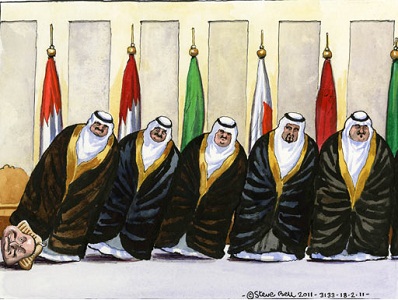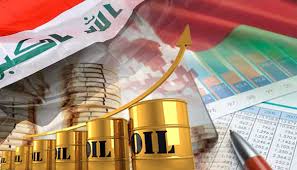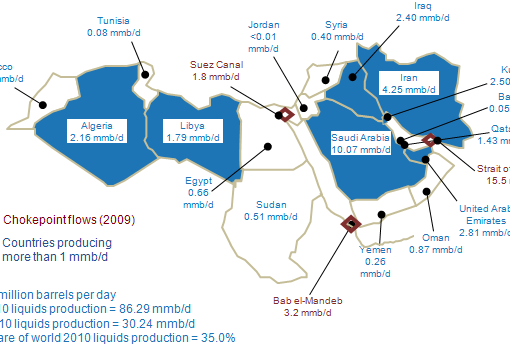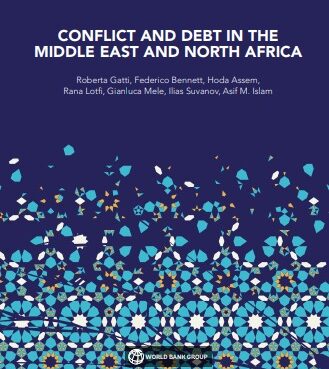Oil prices have plummeted, leaving Saudi Arabia and its allies with a long-term economic crisis — just as Iran’s economy looks poised for rapid gains.
Jeddah’s glittering kilometer-high Kingdom Tower, set for completion in 2018, looms over a Saudi Arabia just beginning to confront the challenge of lower oil prices. The construction of ultra-tall buildings, however, has famously heralded economic crashes in the past: Just five years ago, Dubai’s $1.5 billion Burj Khalifa, the world’s current tallest tower, opened amid the emirate’s financial crisis, part of the worldwide meltdown of property, commodity, and stock prices.
Now Saudi Arabia and its seven Persian Gulf neighbors are hoping history doesn’t repeat itself. Oil prices, above $100 per barrel as recently as June 2014, have plummeted to less than $50 per barrel.
The price drop was a result of rampant U.S. shale oil growth colliding with tepid demand, which was exacerbated this August by the Chinese currency devaluation and stock market crash. With no OPEC consensus on production cuts, Saudi Arabia and its Gulf allies have stumbled into their only strategy — to increase output and try to smoke out their high-cost competitors. Prices may well creep upwards during 2015 and 2016 as shale output declines, but this is counterweighed by slowing Chinese economic growth and its shift to a less energy-intensive track.
But taking in the full view of the region, there’s good reason to believe that the country in the worst economic position today may actually be best placed to overcome the shock.
But taking in the full view of the region, there’s good reason to believe that the country in the worst economic position today may actually be best placed to overcome the shock. Iran is looking forward to the removal of strict sanctions that caused its oil exports to drop from 2.6 million barrels per day in 2011 to a low of 700,000barrels per day in May 2013, and it is anticipating an influx of foreign investment as it reintegrates into the world economy. Meanwhile, its economy is more diversified than those of its Gulf rivals, allowing it to better weather a downturn in oil prices.
The six Gulf Cooperation Council members — Saudi Arabia, Kuwait, Qatar, Bahrain, Oman, and the United Arab Emirates — face two sets of problems during this period of low oil prices. The first is to fund government spending, which is a relatively soluble challenge, and the second is to ensure robust and diversified economic growth, which appears intractable.
And though Britain’s Telegraph newspaper may have blared “Saudi Arabia may go broke before the U.S. oil industry buckles,” Riyadh and its GCC neighbors are not on the verge of collapse. They enjoy political stability, minimal debt, large sovereign wealth funds, and low oil production costs. However, their ability to handle oil prices this low varies considerably: The oil prices needed to balance government budgets, as calculated by the International Monetary Fund, range from $47 per barrel for Kuwait and $59 for Qatar, only a little above current levels, to $73 for the United Arab Emirates, $103 for Saudi Arabia, $94 for Oman, and $93 for Bahrain.
The UAE has been the most proactive in preparing for lower oil prices. It had already begun cutting energy subsidies and trimming the government budget before the slump began. It pricked a nascent real estate bubble in 2013 by raising loan requirements and transfer fees. From August this year, it lifted subsidized gasoline prices to world market levels.
Saudi Arabia is also in a relatively strong position, but it has been burning through its reserves worryingly fast. Net foreign assets fell to $664.4 billion in June from $724.5 billion in January. Over the last decade, government spending has risen largely in step with oil prices, and King Salman ordered$29.3 billion of largesse on his accession in January, as well as the expenses of the war in Yemen. Nor is there any sign of cutting the country’s lavish energy subsidies and rampant domestic oil and gas consumption.
However, Saudi Arabia is said to be working with consultants to slash 10 percent or more from its $102 billion of capital investment this year. With moderate spending cuts and debt financing, the kingdom could sustaindeficits with $40-50 per barrel oil prices for between 7 to 11 years before a fiscal crisis would arrive, said an economist with Bank of America Merrill Lynch.
Kuwait tried to reduce fuel subsidies in January but backed down in the face of parliamentary pressure. There has been talk of improving collection of bills and fines, introducing road tolls, extending taxes to Kuwaiti-owned companies, taxing luxury items, and bringing in a value-added tax. But no one familiar with Kuwaiti politics should expect such measures to pass soon or without controversy. Meanwhile, Qatar continues to float on a cushion of its sovereign wealth and vast gas reserves — but with liquefied natural gas prices tumbling along with oil, it has some longer-term questions of economic strategy to consider.
The budgetary pressure is more acute for Bahrain and Oman, the GCC’s smallest oil producers. Bahrain can probably count on financial support from Riyadh, its big brother across the King Fahd Causeway, which has committed to propping up the royal family against the island’s discontented Shiite majority. Following the suppression of Bahrain’s uprising in 2011, the GCCoffered it and Oman a total of $20 billion of aid.
Oman is in a trickier position. Sultan Qaboos, ruler since 1970, is reportedlysuffering from terminal cancer and has not named a successor. This year, oil production has passed 1 million barrels per day for the first time, but Oman’s complex geology — heavy and viscous oil, deep and low-permeability reservoirs, and numerous small scattered fields — makes its output expensive. Muscat had projected a budget deficit of 8 percent of GDP assuming an oil price of $75 per barrel, and this year’s oil price is set to be substantially lower.
Overall, the GCC’s budgetary problems, if not comfortable, are mostly manageable. An economy, much less a political system, does not collapse just because a country runs a budget deficit.
Devising a new economic and social model has been a much greater problem, and one with which most leading oil exporters have contended in vain. Cutting capital spending saves on budgets but reduces long-term growth. Cuts in generous benefits, salaries, and state jobs for citizens remain politically sensitive, while currency devaluation would be ineffective until a competitive non-oil export sector develops.
Energy-intensive industries, such as petrochemicals and aluminum, and new mines for bauxite, phosphates, and gold do represent a partial diversification, but commodity prices are sinking along with oil. These capital-intensive projects play to the Gulf’s strengths, but do not create many jobs.
Dubai has gone furthest along the road to becoming a post-oil economy. Its success, however, might not be replicable: There is only room in the Gulf for one business hub, and Dubai is well-ahead of Doha and Abu Dhabi.
Dubai is now facing the most stringent test of its economic model. Overall, the emirate is hurt by lower oil prices — it means less trade, tourism, and investment from Gulf neighbors and Russia. This can, however, partly be offset by more visitors from the Indian subcontinent, China, and Europe, lower fuel prices for its flagship airline Emirates, and reduced energy import bills.
Dubai should also benefit from the opening up of Iran, which is sailing into calmer economic waters just as its Arab rivals head into a tempest. Lower oil prices are a serious headwind, but petroleum represents around 20 percent of Iranian GDP, compared to 40 to 50 percent in its Arab neighbors. The Iranian economy is being propelled forward by the prospect of the end of sanctions, the unfreezing of its overseas assets, an influx of foreign investment, and a sharp rise in oil output.
Iran is also set to profit from better political management. President Hassan Rouhani’s government has managed to clean up some of the waste and corruption from the chaotic Ahmadinejad era. Subsidy reform and privatization can further help close the budget deficit. Iran has suffered badly from sanctions, but they have also spurred it to build a sizable, if ramshackle industrial sector. Agriculture, mining, chemicals, automobile manufacturing, and tourism are all promising areas, as well.
If the GCC is in reasonable health, and Iran is convalescent, Iraq’s condition hovers between critical and terminal. The country’s debt, at 37 percent of GDP, is still manageable, but “Nigeria on the Tigris” — as Iraq specialist Toby Dodge dubs it — is plagued not only by the loss of a third of its territory to the Islamic State-caused apocalypse and the interminable dispute over the autonomous Kurdish region’s oil exports and budget, but also by ingrained corruption and mismanagement. Oddly, this means that lower oil prices perhaps matter less to most of its citizens, who see little benefit from their government anyway.
Yet despite all the operational, security, and financial challenges, Iraq is producing a massive amount of oil. International oil companies have raisedIraq’s oil output to a record 4 million barrels per day in June and July, making it OPEC’s second-largest producer (behind Saudi Arabia’s 10.35 million barrels per day) and set to overtake China as the world’s fourth largest.
Swelling production from Baghdad and Tehran, which maintain a political alliance, presented a looming problem for their GCC rivals even last year. The Saudis might have hoped that their low price policy would now have deterred competitors, but China’s slowdown casts doubt on that. Some of the Gulf countries can muddle through for now, but within a few years all will need radical reforms if their towers of industry are not to come crashing down.
Source: Foreign Policy, September 8, 2015








Comment here